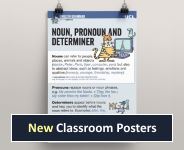Adverbs: Avoiding adverb overuse
Adverbs are quite a varied class of words, which work in several different ways in sentences. Think of examples like obviously, afterwards, extremely, gently. These show that adverbs can express many different kinds of meaning.
This makes adverbs a useful word class. However, many experienced writers advise us to avoid overusing adverbs, and instead find other ways of describing actions and events.
Welcome back!

Englicious is totally free for everyone to use!
But you will have to log in to see our library of teaching resources.
If you don’t have an account, that’s perfectly OK. You can register (for free).
It only takes a minute or two.
»
- Printer-friendly version
- Log in to view or leave comments

